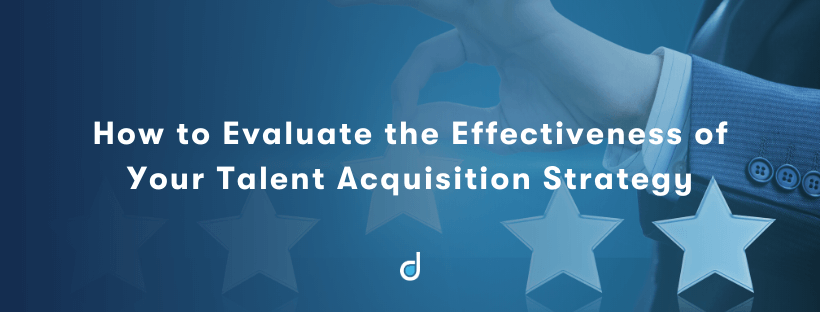Attracting the best talent with key skills to their organisations is one of the biggest challenges companies are facing nowadays. An effective talent acquisition process is crucial to find and hire the right people, ensuring business success. Talent acquisition strategy must be centred on the organisation’s long-term goals in terms of HR strategy. It involves recruiters, sourcing agencies, HR professionals and hiring managers in the activities of sourcing, attracting, interviewing, hiring, and onboarding employees. Instead of simply filling the positions that are open at a given moment, talent acquisition goes further and runs continuously to identify the best candidates for future positions that can be harder to fill, such as executive-level positions, leadership roles, or jobs that require specialised training.
Yet, many companies still haven’t developed a way of evaluating the effectiveness of their talent acquisition strategy. It is of the utmost importance to audit processes and leverage recruitment data to see what it’s working and what needs to be changed. Only this way can companies improve their strategies to meet business goals.
7 Metrics to Assess Your Talent Acquisition’s Effectiveness
Nowadays, it is quite easy to obtain business data and companies must start leveraging recruitment metrics to obtain key information to support their decision making. Metrics allow you to measure the overall health of your talent acquisition process. There are many metrics used to evaluate talent acquisition strategies, however, these are the ones that provide deeper insight into the performance and business impact of a company’s talent acquisition process.
1 - Time to hire
Time to hire let’s you know the number of days between the start of the recruitment process and the moment a candidate gets hired. This metric is all about tracking the speed with which good candidates move within your hiring process once they’ve applied, allowing to analyse a recruiting team’s performance.
Improving this metric means reducing the time it takes to fill a position. Considering most talented people are off the market in 10 days, it also means a shorter process gives you a better chance at attracting and hiring top talent.
Tip: The best way to optimise your time to hire is to break down your hiring process and measure how much time it took to move candidates from one stage to another. Identifying exactly where your hiring team is spending too much time or energy will allow you to take action.
2 - Cost Per Hire
The cost per hire is a central topic when it comes to calculating and managing the recruitment budget. This metric lets you know what is the average amount of money your company spends to make a new hire. It includes all costs related to recruitment, purchase of equipment, onboarding, administrative costs and benefits. And it can vary depending on variables like the company’s size, the seniority of the position, the number of recruitment channels used.
To calculate the cost per hire you need to sum all internal and external recruiting costs and divide them by the total number of hires. Internal recruiting costs include all costs related to the recruitment department, such as recruiter salaries, interviews, fixed costs related to infrastructures, and employee referral program, etc. The external recruiting costs include all expenses related to external vendors and candidates, namely agency fees, advertising, technology, job fairs, travel costs, relocation costs, signing bonuses, etc.
Tip: There are many strategies you can use to reduce your cost per hire and optimise the recruitment process such as building a talent pipeline; allowing employee referrals; using social media to create a strong employer brand, and using an ATS to streamline and expedite your recruitment process.
3 - Qualified Candidates Per Opening
A “qualified candidate” is anyone who passes the application screening process and moves to the next stages of the recruitment process. This KPI is more meaningful than the number of applicants because it shows recruiters how good the candidates they’re attracting are.
It’s really important to measure this metric because if a company realises that they are attracting a lot of unfitted candidates, making it difficult to fill a position, it gives them the opportunity to set new strategies to get better candidates on their funnel.
To calculate the qualified candidates per opening you simply need to divide the number of candidates selected for an interview by the number of candidates presented to the hiring manager.
Tip: To get more qualified candidates to apply to your company you must review your sourcing and advertising methods. Ensure you understand the roles you’re hiring for and define the right job requirements, write effective job descriptions, expand your search for passive candidates to different social networks, and invest more in the most effective source channels.

4 - Sourcing
This metric refers to the performance of the different channels like job boards or social media platforms that you use to advertise your job openings, allowing you to verify which channels are working and which ones need to be reconsidered.
To calculate this metric, candidates need to be tagged according to the acquisition source when they submit their application or to where the recruiter found the profile (LinkedIn, Employee referral, Internal, Facebook, Indeed etc). To gather this data you first need to determine how you want to categorise your sources (e.g. social media vs Facebook, LinkedIn, Twitter, etc.) and then how you will identify those sources. You can use a survey to inquire your candidates about the application process, including where did they find the job opening or implement an applicant tracking system that will record the source a candidate entered your pipeline from, for example.
Tip: Given that there are hundreds of options for sourcing candidates, it’s important to test them and find out which ones are more effective. Once you know which sources provide the greatest number of candidates, you can start looking at which sources produce the best quality candidates over time. In fact, understanding the most effective source of talent for your organisation ensures the best ROI on time and investment spent on recruiting.
5 - Quality of Hire
Quality of hire is at the top of the list of useful performance KPIs for most companies as it measures the value new hires bring to a company. Hiring quality employees means less turnover, more productivity, better culture, and greater overall success for the company. By continuously measuring the quality of hire, you can keep a pulse on the health of your employee base.
As quality is quite hard to evaluate, some quantifiable recruitment metrics can be used instead, such as new hire performance metrics (e.g. meeting X sales quota, delivering Y number of product units or achieving Z customer satisfaction ratings), turnover and retention metrics, hiring manager satisfaction ratings, the percentage of new hires who were promoted within a certain time period, etc.
Tip: Improving the quality of hire requires alignment with leadership to define the factors that make a quality hire at your company and to set the strategies that will help you hire the right people.
6 - Offer-Acceptance Rate
This metric is also essential to evaluate your talent acquisition strategy’s effectiveness. The percentage of job offers accepted is a good indicator of how well your hiring practices are working. Although candidates can decline a job offer due to external reasons (counteroffer from a current employer, etc.), they can also refuse your company’s offer due to reasons related to the company culture, unattractive compensation, or job duties mismatch which could have been detected and managed by your team.
Tip: Use a survey to inquire candidates about the specific reasons behind their refusal.
7 - Satisfaction rate
Although this metric often gets ignored, satisfaction ratings allow you to know how candidates are experiencing your hiring process. To measure it you can use surveys of candidates and new hires. This metric is essential to understand what may be causing high numbers of interview cancellations, no shows, or high turnover rates in new hires.
Tip: Build a survey that is easy and quick to answer, focusing only on key satisfaction aspects regarding the recruitment process, to get more answers. Also, don’t forget to protect the candidates’ privacy.
Evaluating your talent acquisition strategy with a data-driven approach will allow you to have a more holistic view of how talent acquisition is impacting the business strategy and how you can improve it so that you can consistently and efficiently attract and hire the best talent.

Skeeled offers you the perfect opportunity to bring innovation and digitalisation to your hiring. Check our website or our LinkedIn, Twitter and Facebook pages for further information.
Thanks for reading and see you next time!
Your team here at skeeled


.png)

